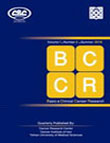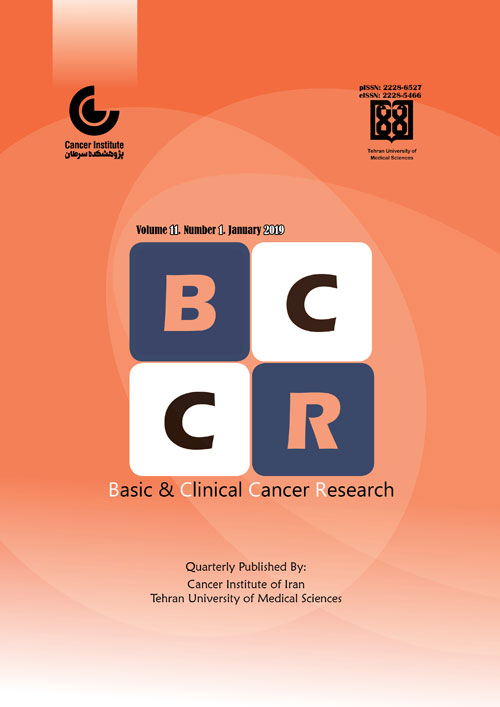فهرست مطالب

Basic and Clinical Cancer Research
Volume:7 Issue: 4, Autumn 2015
- تاریخ انتشار: 1394/10/10
- تعداد عناوین: 5
-
-
Pages 2-8PurposeThe aim of this study was to test the in vitro sensitivity of lymphocytes of patients with head and neck cancer against gamma irradiation and also to find out if the frequencies of chromosomal aberrations correlate with side effects of radiotherapy.
Patients andMethodsPeripheral blood of 101 patients with head and neck cancer was collected before the onset of radiotherapy, cultured and irradiated in the G2- or the G0- phase of the cell cycle. Lymphocytes of 40 healthy donors were treated in the same way. Chromosomal aberrations such as chromosome and chromatid breakages, chromosome and chromatid gaps, chromatid exchanges and micronuclei were scored in metaphase cells of the patient and control groups.ResultsThe frequency of radiation- induced G2 aberrations in lymphocytes of patients were on average higher than in those of healthy donors (P=0.001 for chromosomal breaks). The frequency of radiation-induced micronuclei in the G0 assay were also higher in patients than in those in controls (P=0.05). The results also indicate that there is no correlation between the two assays. No significant correlation was observed between aberration frequencies in lymphocytes and the degree of both early and late normal tissue reactions.ConclusionThe induced chromosomal aberration frequency of lymphocytes of patients with head and neck cancer are higher than those in healthy individuals, however, it does not appear to have a predictive value for the risk of developing side effects to radiotherapy.Keywords: Head, neck cancer, gamma irradiation, G2 assay, micronuclei assay -
Pages 9-17This study aimed to determine the relationship between lifestyle and health locus of control with happiness in college students. This study was descriptive within the framework of a correlation prediction plan. The sample consisted of 331 undergraduate students of Talesh PNU (246 females and 85 males) 1393-94 academic years who were selected randomly and completed lifestyle questionnaire, health locus of control scale and Oxford Happiness Questionnaire. The data was analyzed using descriptive indicators of mean and standard deviation and Pearson correlation coefficient and stepwise regression methods. The results showed that the relationship between lifestyle and dimensions of happiness were positive and significant. The relationship between internal locus of control with happiness was positive, but in its relation with external locus of control, the chance was negative. Relationship with other locus of control and happiness was not significant. Also, regression analysis showed that 43 percent of happiness are explained by lifestyle and internal locus of control. Based on the findings, we can conclude that the style life and health locus of control affect the level of student's happiness.Keywords: Happiness, Lifestyle, Health Locus of Control
-
Pages 18-22We report occurrence of a rare case of Giant Cell Tumor (GCT), in a 28-year old woman, arising from anterior arc of right 6th rib during pregnancy. It progressed rapidly during breast-feeding period, mimicking malignant bone tumor at delayed presentation.Keywords: Bone tumor, Giant cell tumor, Chest wall, Pregnancy
-
Pages 23-33Recent advances in nanotechnology have rapidly developed new therapeutic and diagnostic concepts in all aspects of medicine. Magnetic nanoparticles (MNPs) can be simultaneously functionalized and guided by a magnetic field, thus providing promising tools for several biomedical applications. MNPs contrast agents at low concentrations offer the potential to significantly improve existing methods of cancer diagnosis and treatment. In addition to imaging, MNPs can be designed so that they can selectively accumulate in cancer cells and providing targeted treatments that may not be possible with conventional techniques. To this end, MNPs need to have a special surface coating, which causes these materials to be non-toxic, biocompatible and targetable. The treatment of cancer by hyperthermia method could be more effective by using MNPs-based drugs, because they can manipulated under an external magnetic field and increase the efficiency of treatment due to the accumulation of these particles in tumor targets. Therefore development of MNPs could be effective for theragnostics application because they can facilitate the imaging and drug delivery and also could be useful in disease therapy. This Review provides a brief introduction to some of potential applications of magnetic nanoparticles in biomedicine especially in the detection, diagnosis and treatment of malignant tumors.Keywords: Magnetic Nanoparticles, MRI, Drug Delivery, Hyperthermia, Cancer
-
Page 34BackgroundNonalcoholic fatty liver disease (NAFLD) is becoming a significant problem especially through substantial increase in the incidence of obesity worldwide. Currently it is the most common cause of abnormal serum aminotransferase levels both in low- and middle-income countries and in high-income countries and despite its high prevalence, well-defined screening recommendations are currently lacking.ObjectivesThe purpose of this study was to calculate statistical values of cherry angioma in the diagnosis of NAFLD. We were looking for evidence to be able to recommend cherry angioma as a screening tool for NAFLD that needs further investigations including ultrasonography.
Patients andMethodsWe studied individuals who visited the private clinic between July 2011 and December 2012 for health examinations. Physician evaluated each individual by different laboratory tests for systemic, viral and hereditary diseases and excluded those with any of these disease. After completion of physical examination, registration of the cherry angioma diagnosis and lab tests, 340 individuals referred to a radiologist for the diagnosis of NAFLD by abdominal ultrasonography.ResultsAmong 340 study subjects, 150 (44%) were males and 190 (55%) were females. Mean of age and BMI were 47.9 years and 26.9 kg/m2, respectively. Of referred individuals, we diagnosed 238 persons as fatty liver disease through abdominal ultrasonography. We assigned them as NAFLD group. The other 102 individuals were identified with normal livers and were assigned as non-NAFLD group. There was no difference in age and height but for weight and BMI between individuals of NAFLD and non-NAFLD groups. Individuals in NAFLD group were more obese than those in non-NAFLD group. Overall, sensitivity, specificity, PPV, NPV and accuracy were, 76.9, 80.4, 95.8, 37.5, and 77.4, respectively. All values were higher among women than men. The highest sensitivity was observed in individuals with age >40 years, and the highest specificity was observed in individuals with age ≤40 years.ConclusionsIn conclusion, NAFLED can be sufficiently predicted by cherry angioma on physical examination.Keywords: Non, alcoholic Fatty Liver Disease (NAFLED), Cherry Angioma, Sensitivity, Specificity


